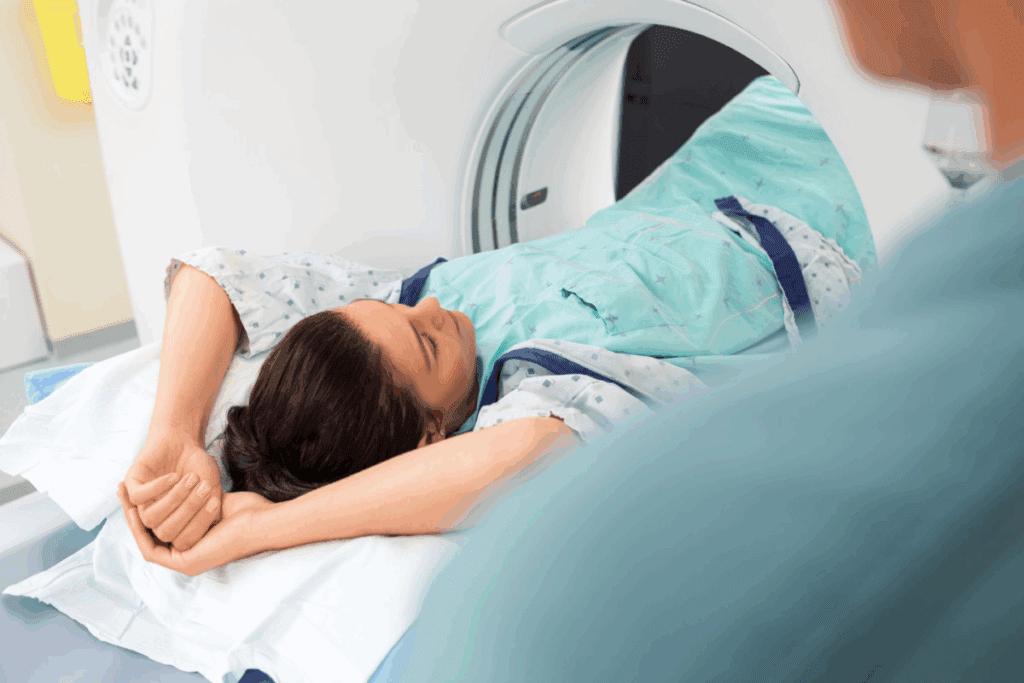Last Updated on November 26, 2025 by Bilal Hasdemir

Finding colon cancer early can make a major difference in treatment success. There are several ways to detect it, including blood tests and imaging scans. Many people ask — will colon cancer show up on a CT scan?
In most cases, colon cancer will show up on a CT scan, especially when the disease has developed into visible tumors or has spread. CT scans provide detailed images of the colon, helping doctors identify abnormal growths or other signs of cancer. However, small or early-stage tumors might require additional tests, such as a colonoscopy or biopsy, for confirmation.
At Liv Hospital, we use advanced diagnostic techniques to ensure every patient receives the most accurate results and best possible care. With the right tools and expert analysis, doctors can detect colon cancer early and improve treatment outcomes.

Colon cancer happens when cells in the colon or rectum grow out of control. This forms a tumor. It’s a big health issue, mainly for older adults.
Colon cancer, also known as colorectal cancer, is when tumors grow in the colon or rectum. It starts as a growth or polyp on the inner lining. Some polyps are harmless, but others, like adenomatous polyps, can turn cancerous over time.
There are several things that can raise your risk of getting colon cancer. These include:
Signs of colon cancer include:
Knowing these risk factors and warning signs is key. It helps catch colon cancer early, when it’s easier to treat.

Finding colon cancer early is key. It makes treatment more effective and boosts survival chances. Colon cancer is most treatable when caught early.
Early detection is very important. Finding colon cancer early means better treatment chances. Early-stage cancer is usually smaller and hasn’t spread far.
Survival rates for colon cancer depend on when it’s found. The American Cancer Society says the 5-year survival rate is about 90% for early-stage cancer. But, it drops to 71% if cancer has spread to nearby lymph nodes. And it falls to 14% if it’s spread to distant parts of the body.
Stage at Diagnosis is key to knowing what to expect. Stages are:
Screening tests help find colon cancer early. They catch cancer before symptoms show, when it’s easier to treat. Screening has many benefits:
For women, knowing how to test for colon cancer is vital. Screening advice depends on risk factors, family history, and age. Regular screening can greatly improve survival rates by catching the disease early.
CT scans are key in finding colon cancer. But, how well they work depends on several things. We’ll look at what CT scans can and can’t do in spotting colon cancer.
CT scans are pretty good at finding colon cancer, mainly for bigger tumors. Research shows they can spot colon cancer with 80% to 90% accuracy. This depends on the tumor size and the scan technology.
Detection Rates by Tumor Size:
| Tumor Size (cm) | Detection Rate (%) |
| 60-70 | |
| 1-2 | 80-85 |
| >2 | 90-95 |
Several things can change how well a CT scan finds colon cancer. These include:
CT scans work well for finding big tumors. But, they’re not as good at spotting early colon cancer or small growths. Early colon cancer might have tiny tumors or polyps that CT scans can miss.
Because of this, we need other tests like colonoscopy or stool tests to make sure we catch all colon cancer early.
Virtual colonoscopy, or CT colonography, is a new way to see the colon and rectum. It uses CT scans to make detailed images. This helps find colon cancer early.
CT colonography uses a CT scanner to take X-ray images of the abdomen and pelvis. These images are turned into a 3D model of the colon and rectum. Patients need to prepare their bowels like for a regular colonoscopy, but some methods differ.
“CT colonography has become a key tool for finding colorectal lesions,” studies say. The procedure is fast, taking 10-15 minutes, and doesn’t need sedation.
CT colonography is less invasive than traditional colonoscopy. It doesn’t use a colonoscope. This is good for those who are scared or have had bad experiences with traditional colonoscopy. But, if it finds polyps or issues, a follow-up colonoscopy might be needed.
| Feature | CT Colonography | Traditional Colonoscopy |
| Invasiveness | Non-invasive | Invasive |
| Sedation Required | No | Yes |
| Biopsy Capability | No | Yes |
CT colonography is non-invasive and has fewer risks. It lets doctors see the colon without sedation. But, it can’t do biopsies or remove polyps.
It also uses some radiation, but the amount is small. It’s good at finding big polyps but might miss small ones.
In summary, CT colonography is a good choice for colon cancer screening. It’s less invasive than traditional colonoscopy. While it has its downsides, its benefits make it a valuable option for some patients.
Blood tests play a big role in finding colon cancer. They give important health info and can spot signs of colon cancer.
A Complete Blood Count (CBC) checks different parts of the blood. It looks at red and white blood cells, hemoglobin, and hematocrit. For colon cancer, a CBC can show anemia.
Anemia is a common problem in colorectal cancer. It happens when the body loses too much blood because of the tumor.
For example, a person with colon cancer might have fewer red blood cells or less hemoglobin. This means they have anemia. A CBC isn’t a test for colon cancer itself. But, it can point to problems that need more checking.
Tumor markers are substances in the blood, urine, or tissues of some cancer patients. Carcinoembryonic antigen (CEA) is a marker linked to colorectal cancer. High CEA levels might mean cancer is present, but it’s not the only sign.
Researchers are looking into other biomarkers for colon cancer. These include proteins, genetic changes, and other molecules. They might help find colon cancer more accurately.
Understanding blood test results for colon cancer needs careful thought. One test alone can’t diagnose cancer. It’s used with other tests and doctor’s checks.
It’s key to know that blood tests are not the only way to find colon cancer. A full check-up, including imaging and colonoscopy, is needed for a sure diagnosis.
New technologies have changed how we find and treat colorectal cancer. These changes offer hope for catching cancer early and treating it better.
Blood-based biomarkers are key in finding colorectal cancer. They are substances in the blood that show cancer is present. Research has found several promising biomarkers, like proteins and DNA, linked to colorectal cancer.
One big plus of these biomarkers is they can be tested with a simple blood draw. This is less invasive than older methods, making them more appealing to patients.
Genetic testing in blood samples is also advancing in colorectal cancer diagnosis. It looks at the genetic material in blood to find cancer-linked mutations. This helps find high-risk people and catch cancer early.
Genetic testing also tells doctors about the tumor’s genetics. This helps choose the best treatment for each patient. This personalized care is key in fighting colorectal cancer.
The field of blood tests for colorectal cancer is growing fast. New technologies are making blood tests better at finding colorectal cancer.
New tools include advanced genomic analysis and machine learning. These tools can spot complex patterns in blood samples. They promise to make diagnosing colorectal cancer more accurate and less invasive.
As research keeps improving, we’ll see even better blood tests and biomarkers. These will be vital in finding and treating colorectal cancer early. This will lead to better outcomes for patients.
Stool-based tests are a non-invasive way to screen for colorectal cancer. They check stool samples for cancer or precancer signs. This is good for those who don’t want more invasive tests.
The Fecal Occult Blood Test (FOBT) finds hidden blood in stool, a cancer sign. It’s suggested for people at average risk, starting at age 45. There are two types: guaiac-based FOBT (gFOBT) and fecal immunochemical test (FIT). FIT is more specific and doesn’t need special diet.
The Fecal Immunochemical Test (FIT) also finds blood in stool. FIT is more sensitive than gFOBT and needs only one or two samples. It’s easier for patients because it doesn’t require special diet or handling many samples.
Stool DNA testing is advanced and finds DNA changes in stool that might show cancer. This test looks for blood and DNA markers, making it more sensitive. It’s not as common as FOBT or FIT but is a good option for non-invasive screening.
In summary, stool-based tests are key in finding and preventing colorectal cancer early. Knowing about these tests helps people choose the best screening for themselves.
Colonoscopy is the top choice for finding colon cancer. It lets doctors see the colon and rectum directly. This helps them spot polyps and cancerous growths accurately.
A colonoscopy uses a flexible tube with a camera to look at the colon. Preparation is key for a good procedure. Patients eat only clear liquids the day before and clean their bowels to clear the colon.
The procedure is done under sedation to make it comfortable. Doctors can remove polyps and take biopsies during the colonoscopy. This helps diagnose and treat polyps that could become cancerous.
Colonoscopy has many benefits for diagnosis. It lets doctors see the whole colon, spotting polyps and tumors that other tests miss. The ability to take biopsies makes it even more useful.
| Diagnostic Feature | Colonoscopy | Other Imaging Techniques |
| Direct Visualization | Yes | No |
| Biopsy Capability | Yes | Limited |
| Polyp Removal | Yes | No |
Colonoscopy is suggested for those with a family history of colon cancer, symptoms, or are over 50. How often you need it depends on your risk and past results.
In summary, colonoscopy is a key tool against colon cancer. It lets doctors see the colon, remove polyps, and take biopsies. This makes it essential in the fight against colon cancer.
There are imaging methods beyond CT scans and colonoscopy for finding colon cancer. These methods help doctors understand the disease better. They help in planning the best treatment.
Magnetic Resonance Imaging (MRI) is a non-invasive way to see the colon and nearby tissues. It uses magnets and radio waves. MRI scans are great for seeing how far cancer has spread and if it’s in lymph nodes.
MRI scans give clear images of soft tissues. This helps doctors know the size and location of tumors. It also shows if cancer has spread to nearby areas.
Positron Emission Tomography (PET) scans help find colon cancer. They use a radioactive material that cancer cells absorb. The PET scanner then shows where the cancer is.
PET scans are good for finding cancer in other parts of the body. They also help see how well treatment is working. They can spot cancer coming back.
Ultrasound is sometimes used to check for colon cancer. It’s mainly for looking at liver metastases or guiding biopsies. Ultrasound is not as common for finding colon cancer but can be helpful in some cases.
New techniques like Contrast-Enhanced Ultrasound and Photoacoustic Imaging are being looked into. They might make finding colon cancer even better. These new methods could give more details about tumors.
These imaging methods are getting better. They help us find and treat colon cancer more effectively.
Colon cancer detection needs different methods for various groups. The risk, symptoms, and best screening vary by demographic.
Women face unique challenges in colon cancer screening. They might have a higher risk for certain types of cancer. Hormonal factors can also impact their screening results.
Key Considerations for Women:
Those with a family history of colon cancer or certain genetic syndromes are at high risk. They need aggressive and early screening.
“For individuals at high risk, screening colonoscopy is often recommended starting at age 40, or 10 years before the age at which the youngest family member was diagnosed.”
Screening Strategies for High-Risk Individuals:
| Risk Factor | Recommended Screening | Age to Start |
| Family History | Colonoscopy | 40 or 10 years before youngest family member’s diagnosis |
| Genetic Syndromes (e.g., Lynch Syndrome) | Colonoscopy or Genetic Testing | Varies by syndrome, often in early 20s |
| Personal History of IBD | Colonoscopy | 8-10 years after diagnosis |
Age is key in colon cancer screening. Guidelines suggest starting at 45 for average-risk adults. The type and frequency of screening depend on age and risk.
Age-Based Screening Guidelines:
By focusing on the unique needs of each group, healthcare can better detect colon cancer.
Finding colon cancer early is key to better treatment and survival. A detailed diagnostic plan is vital for catching the disease early.
There are many ways to find colon cancer, like CT scans, blood tests, stool tests, and colonoscopies. Each method has its own strengths and weaknesses. A good plan takes into account a person’s risk and health history.
Using different tests together helps doctors find cancer more accurately and treat it better. A detailed plan helps patients get the right care on time. This improves their life quality and treatment results.
Spotting colon cancer well needs a mix of tests and thinking about each patient’s needs. With a thorough plan, doctors can help patients more and lower cancer risk.
CT scans can spot colon cancer, but it’s not always accurate. The accuracy depends on the cancer’s stage and the scan’s quality. They can find larger tumors but might miss early-stage cancer or small polyps.
Blood tests, like Complete Blood Count (CBC) and tumor marker tests, can hint at colon cancer. Yet, they’re not enough to confirm it. They can give false results.
CT colonography, or virtual colonoscopy, is a non-invasive test. It uses CT scans to see the colon. It can find colon cancer and polyps, but its success depends on the scan quality and bowel prep.
Doctors use several tests to diagnose colon cancer. These include colonoscopy, CT scans, blood tests, and stool tests. Colonoscopy is the best way to see the colon and take biopsies.
Finding colon cancer early can greatly improve survival chances. Screening can catch cancer when it’s easier to treat. It can also stop cancer by removing polyps before they turn cancerous.
Yes, tests like Fecal Occult Blood Test (FOBT), Fecal Immunochemical Test (FIT), and stool DNA testing can find colon cancer. They look for blood or abnormal DNA in stool.
Several factors increase the risk of colon cancer. These include age, family history, and having polyps or cancer before. Inflammatory bowel disease and certain genetic syndromes also raise the risk.
Screening for colon cancer depends on age, risk factors, and medical history. Most adults should start screening at 45 or 50. Then, they should get screened regularly as advised by their doctor.
Genetic testing can find genetic mutations that raise colon cancer risk, like Lynch syndrome. But, it’s not a test for diagnosing colon cancer. It should be used with other screening tests.
Blood tests have their limits in finding colon cancer. They can give false results and miss early cancer. They should be used with other tests for a full diagnosis.
U.S. Preventive Services Task Force (USPSTF). (2021). Screening for colorectal cancer: U.S. Preventive Services Task Force recommendation statement. JAMA, 325(19), 1965–1977. https://pubmed.ncbi.nlm.nih.gov/34003218/
Pickhardt, P. J., Hassan, C., Halligan, S., & Marmo, R. (2011). Colorectal cancer: CT colonography and colonoscopy for detection—systematic review and meta-analysis. Radiology, 259(2), 393–405. https://pubmed.ncbi.nlm.nih.gov/21324844/
Subscribe to our e-newsletter to stay informed about the latest innovations in the world of health and exclusive offers!